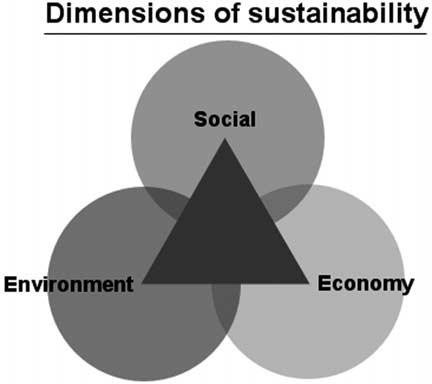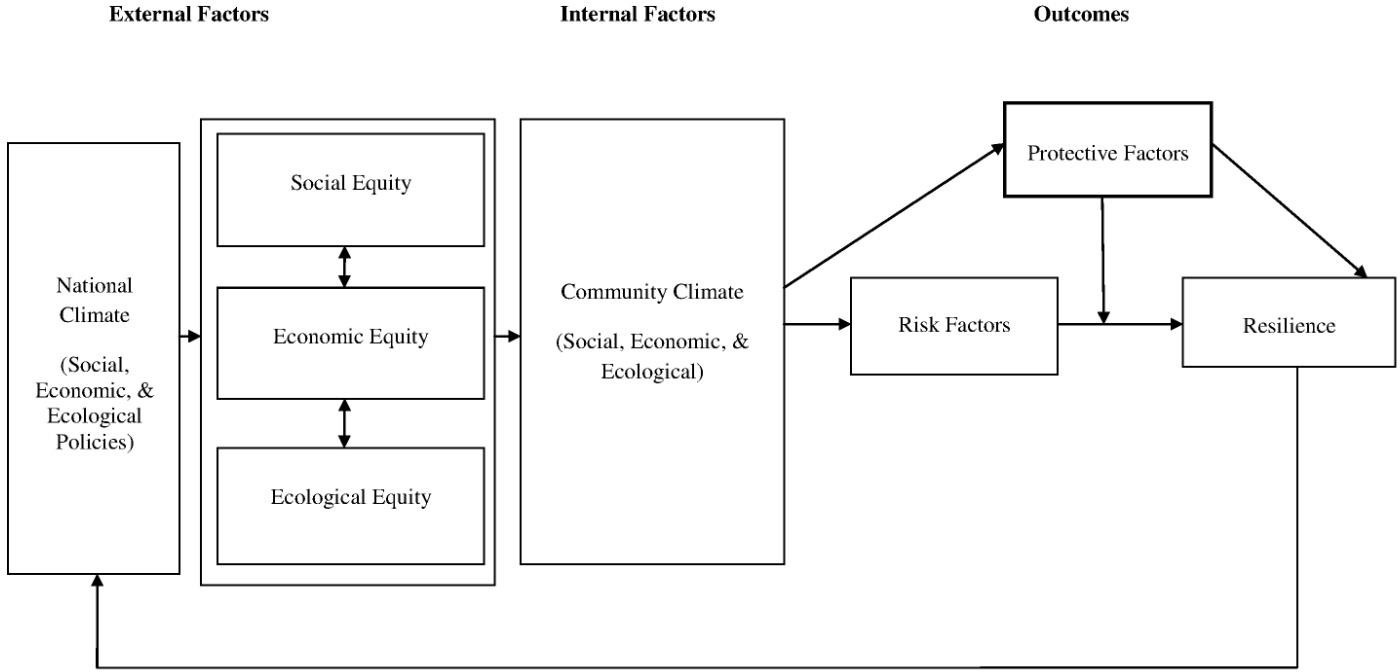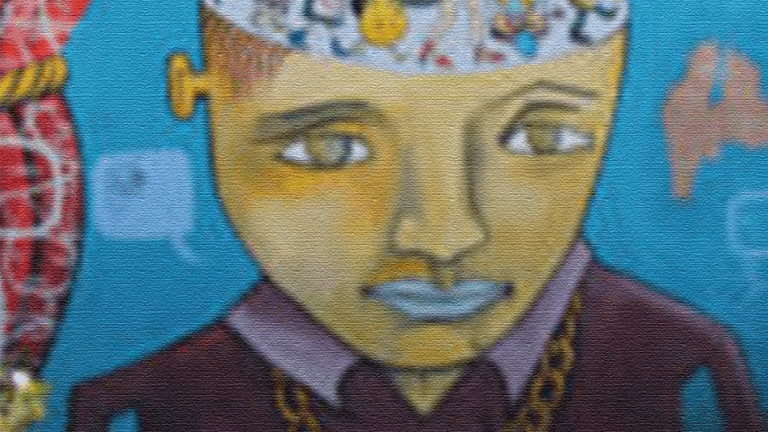Beyond Sustainability: A New Conceptual Model
Molly Kerby
Western Kentucky University
Gayle Mallinger
Western Kentucky University
Author Note
Molly Kerby, Assistant Professor, Department of Diversity Studies, Western Kentucky University and Gayle Mallinger, Assistant Professor, Department of Social Work, Western Kentucky University.
Correspondence regarding this article should be addressed to Molly Kerby, Assistant Professor, Department of Diversity Studies, Western Kentucky University, 1906 College Heights Blvd #21066, Bowling Green, KY 42101. Phone: 270-745-6952. Fax: 270-745-6861. Email: molly.kerby@wku.edu.
Abstract
Over the last few decades, the notion of sustainability has become an interdisciplinary buzz word. Sustainability has been an integrative concept that includes three constructs or pillars: a) social; b) economic; and c) ecological. Until recently, theoretical approaches based on the three pillars approach have operated in silos rather than exploring the interconnectedness of the constructs. Few models have moved beyond the idea that logical relations exist among the constructs (social, economic, and ecological) to consider factors external to communities, nor have they examined the internal socio-economic factors that influence positive outcomes. While this conceptualization has raised awareness about the distribution of scarce resources, it has not been useful in creating resilient and sustainable development. The model proposed in this paper is theoretically driven and considers the multifaceted concepts of ecological perspectives and risk and resilience. In addition, unlike previous conceptual representations, the model suggested in this paper offers opportunities for intervention to decrease risk, promote community cohesion, and encourage social change through empirical investigation.
Keywords: sustainability, ecological, social, economic
Introduction
Over the last three decades, the word sustainability has become a metaphor for environmental justice, social good, and economic resilience. The field of forestry originally adopted the concept of sustainability to refer to the practice of ethical harvesting—never cutting more than the forest yields in new growth (Wiersum, 1995). Eventually, the use of the term spread into other fields such as ecology, economics, and sociology. In 1987, the meaning of sustainability and sustainable development was expanded in The Report of the World Commission on Environment and Development: Our Common Future (more commonly known as the Brundtland Commission Report). The report attempted to address the growing need for “development which meets the needs of the present without compromising the ability of future generations to meet their own needs,” which has since become the definition of sustainability (Brundtland, 1987, ch. 2, para. 6).
As a result of the Brundtland Commission Report, the term sustainability became the guiding principle of long-term environmental strategies that considered the interrelationships among people, resources, environment, and development as well as focusing on the problems of exploitation and depletion of natural resources and the international concern of economic development at the expense of environmental quality (Keiner, 2003). It also became apparent that the meaning and definition of the word sustainability has several dimensions. Most importantly, the report called attention to the dichotomous relationship between humans and nature (ecology) and the multiple dimensions, or pillars, of sustainable development.
In 1992, delegates from the United Nations met for the first global environment conference (Earth Summit) in Rio de Janeiro, Brazil, to rethink global economic development, depletion of natural resources, and pollution (UN, 1997). The common goals of the sustainability outlined in reports from this first Earth Summit were similar to those developed in the Brundtland Commission Report: a) human needs and rights are central; b) global economic growth is paramount; and c) equitable systems and cooperation are imperative. Similar meetings, (RIO +5, 1997; RIO +10, 2002; RIO +20, 2012) addressed the growing concerns about global income inequity and its relationship to the deterioration of the environment world- wide and its connection of the social, economic, and environmental dimensions of sustainability.
The challenge in using the three pillar analogy, however, lies within the notion of sustainability as an integrated process. Since the Brundtland Report and subsequent United Nation summits, the three pillars have been abandoned in favor of interconnected circles (Figure 1.). While the concentric approach to sustainability has been advantageous in building awareness of its complexity, it offers no means for multidimensional analysis. In order for effective integration of intra- and interdependent variables to occur, the boundaries between them must be fluid. In other words, the social, economic, and environmental factors that comprise the interconnected circles are inherently influenced and affected by one another. A comprehensive understanding of the relationship among these factors can lead to a shift in both praxis and practice in sustainable development. The concentric circles approach also assumes there should be balance among the factors which encourages unnecessary trade-offs in order to produce homeostasis. This notion contradicts the idea that interdependence among factors and collaboration are crucial (Gibson, 2006).
The Three Pillars of Sustainability

Figure 1. (Source Keiner, 2003, p. 381)
In order to build sustainable communities, the pillar approach in which social, economic, and environmental domains operate in a silo with little overlap must be revamped. It is imperative to note that few models, if any, consider external factors that directly impact resilience beyond sustainability nor do they consider critical theoretical foundations. While the pillar approach and concentric circles positioned scholars and activists to consider the complexities of social, economic, and environmental degradation, neither is useful in enacting transformation and policy reform. In order to investigate these multi-dimensional constructs, it is vital to create testable models grounded in theoretical concepts and perspectives.
Theoretical Framework
Risk and resilience and ecological theories combine to form the basis for the applied conceptual model described in the following sections of this paper. The blend of these two concepts highlight the value of examining risk and protective factors in the person’s immediate and remote environments and considers the additive and interactive effects of risk and context. These paradigms not only serve to explain but also to guide intervention efforts at ameliorating community risks in multiple contexts. While these theories are rooted in the field of child development, they both have utility in creating structural models that lead to community resilience.
Ecological theory recognizes the importance of the interactive influence of environmental systems, both formal and informal, on individuals, families, and communities. Bronfenbrenner’s theory of human ecology (1979) emphasized the significance of the influence of social context on development. Bronfenbrenner (1977) proposed that development occurs within a context of reciprocal interactions between the person and environment. He conceptualized the environmental structures as nested: microsystems, or the interaction between individuals and their immediate environment; mesosystems, which include connections between microsystems, such as the relationship between teachers and the parent; exosystems, or the connection between the structures of the individual’s microsystem; macrosystems, or cultural value, customs, and laws; and chronosystems, or socio-historical conditions (Bronfenbrenner, 1979).
Social networks may be defined as linkages among a set of significant others that hold importance and considered supportive or maladaptive (Garbarino & Abromowitz, 1992; Germain & Gitterman, 1980). This theoretical perspective takes into account macrostructural influences including racism, sexism, and economic conditions that affect communities. Therefore, change in one level affects the other systems, thereby influencing the individual (Bronfenbrenner, 1979).
Risk and resilience has been widely used as a conceptual framework to explain variation in outcomes for children in jeopardy for developing problems due to difficult life experiences. Risk refers to individual, specific life events, and/or contextual factors which place individuals in danger of adverse outcomes (Fraser, Richman, & Galinsky, 1999). While the concept of risk and resilience emerged from research on adolescents, it is applicable to the general population as well. For example, stressors may occur on a micro (for example, low intelligence or difficult temperament), meso (for instance, an abusive parent) or macro level (for example, impoverished neighborhood). Children residing in impoverished communities have less access to positive role models than their counterparts living in resource-rich environments and thus are at risk for negative physical and emotional health and poor school achievement (Brooks-Gunn & Duncan, 1997; Ozer & Weinstein, 2004). In addition, children living in poverty are at significantly greater risk to be victims or perpetrators of violence (Ahern, Galea, Hubbard, Midanik, & Syme, S. L., 2008; Cooley-Strickland, Quille, Griffin, Stuart, Bradshaw, & Furr-Holden, 2009). Children living in substandard housing had worse affective and cognitive functioning than did their counterparts living in adequate dwellings (Coley, Leventhal, Lynch, & Kull, M., 2013). Despite adverse circumstances, some children at high risk for negative outcomes succeed—they are resilient.
Resilience is the ability to overcome negative consequences and thrive (Masten, 2007; Rutter, 1979; Xue, Zimmerman, & Caldwell, 2007).). This occurs when individual, family, and social circumstances disrupt the trajectory from risk to negative outcomes. These protective factors are internal and external resources that are believed to compensate for, mediate, or moderate risk for negative social or health outcomes (Fraser, Kirby, & Smokowski, 2004; Rutter, 1999). Thus, by definition, a protective factor may only occur in the presence of risk. Protective processes are environmental conditions which occur outside of the control of the individual (Small & Memmo, 2004). These factors include family structure, social support, and community opportunities (Fraser, et al., 2004).
Although ecological theories and risk and resilience have traditionally described risk and protective factors in terms of children, both have roots in ecological and human ecology theory and are useful in building empirical models that consider the diversity and complexity of ecological systems in relation to community resilience. Constructing models that allow researchers to measure the impact of protective factors on resilience must allow for the effects of national climate and policy, factors external to communities (especially in terms of equity), community climate, and risks unique to particular communities.
Empirical Model Development
Much of our understanding of empirical model development and its complexities comes from an examination of systems thinking and dynamics. Simply stated, systems thinking assumes that everything is connected, each segment is as important as the next, and can “accept complexity, nonlinearity, and feedback loop structures that are inherent in social and physical systems” (Forrester, 1994, p. 3). Because we are concerned with solving problems related to sustainability with long-term benefits related to social, economic, and ecological dimensions, these dynamic systems cross many fields and disciplines and require multidisciplinary investigations (Sterman, 2001).
One approach, derived from systems thinking, is to create a conceptual model for sustainability using influence diagramming or path modeling that can be empirically tested. A path model provides a graphic image for articulating the understanding of the dynamics of interconnectedness. They are constructed by linking together key variables and indicating the causal relationships between and among them. A hypothesis about a particular problem can be made by connecting the causal paths formed from constructs that influence one another (Kim, 1992). For example, Figure 2 begins with considering the external influences of national climate, which is connected by directional arrows to both equity factors (social, economic and ecological), and internal factors through paths.

Figure 2. New conceptual model of sustainability
National climate in this model refers to national strategies regarding social, economic, and environmental, or ecological, policy. In theory, decision-making at the national level involves developing polices that promote social, economic, and ecological sustainability. A fundamental question in drafting these policies, however, is that of defining and measuring impact and outcome (Andriantiatsaholiniaina, A., Kouikoglou, V.S., & Phillis, Y. A., 2003). While governments create separate policies to deal with social, economic, and ecological inequities, movement toward cross-governmental cooperation in terms of creating integrated sustainability is virtually nonexistent (Ostrom, 2007). For example, although the United States spends more money on health care than any other nation, the health of its citizens lags behind most industrialized countries because of persistent health inequities related to race and class (Brulle, & Pellow, 2006). In response to the Brundtland report and succeeding United Nation meetings, government agencies explored the role of environmental pollution on well-being but little attention was paid to health inequities. Research indicates that people of color and the poor bear the larger share of the health burden from exposure to environmental toxins because they tend to live in communities located near chemically hazardous facilities (Brulle, & Pellow, 2006). The construct of national climate, therefore, is directly linked to the external factors of social, economic, and ecological equity.
Factors of equity in this model are also external constructs considered to directly impact community climate but are shaped by national climate and policies. However, while the concentric diagram in Figure 1 includes socio-economic sustainability, there are two dimensions of this construct. The first dimension, as depicted in Figure 2, is influenced by national climate and impacted by social, economic, and ecological policies. The concept socio-economic sustainability is treated as a variable related to the national climate in terms of social, economic, and ecological equity at the policy level. The second dimension in this model is considered an internal factor called community climate. While community climate is directly impacted by external policy related to equity, the internal social, economic, and ecological factors are defined more closely by perceptions of place and interpersonal networks (Pretty, 1990).
Though the external and internal dimensions of equity are impacted differently, they are connected. For example, understanding the social, economic, and ecological factors of food security and nutrition is critical in confronting the global problem of hunger and poverty. National policies (see, for example, the Farm Bill of 2014) and the global market cannot solve the problem of food insecurity because these entities are not the producers of these goods—they merely serve as an influence.
The principles of risk and resilience and ecological theory are addressed in Figure 2 as outcomes using protective factors as mediators or moderators. In this example, to reduce risks, protective factors such as good agricultural practices and technologies, educational opportunities, financial services, and community support increase the probability of achieving a sustainable and resilient food system. In other words, the key to solving the multidimensional food crisis is to build solidarity among communities (i.e., farmers, health workers, schools, and communities). These various communities can join as advocates for changes in national policy.
What sets this sustainability model apart from others is the conceptualization of the direct impact of resilience on national climate and social, economic, and ecological policy. At the root of this causal path are the combined concepts of empowerment and social capital. According the Zimmerman (2000), empowerment “is both a value orientation for working in the community and a theoretical model for understanding the process and consequences of efforts to exert control and influence over decisions that affect one’s life, organizational functioning, and the quality of community life” (p.43). Empowerment in this case becomes a positive protective factor aimed at moderating community risks and increasing resilience. By creating individual change through empowerment, communities trust is strengthened to build social capital. Social capital, or the combined relation of individuals within a group with similar goals, can facilitate greater change than a community without the addition of trust and empowerment (Coleman, 1988). Thus, the model in Figure 2 provides researchers the opportunity to measure both causal relationships and longitudinal processes that inform policy changes.
Implications for Methodology
Path models or influence diagrams are designed to examine the strength of direct and indirect relationships among variables. While relationships cannot be specifically tested for directionality, researchers, informed by theory, can hypothesize causal systems of relationships between and among correlates (Lleras, 2005). For example, in this model, it is hypothesized that risks are directly affected by social, economic, and ecological factors related to community climate. It is further hypothesized that the external factors of equity/inequity and national climate (social, economic, and ecological policies) then, in turn, predicts risk. In terms of further analysis, this part of the model is then mediated or moderated (depending on hypotheses) by protective factors that impact resilience. As an added analytic tool, the arrow drawn from resilience back to national climate enables research to examine the influence of resilience, based on the effects of the model, on national climate and polices.
This path model lends itself to a holistic, theoretical process for answering the complex questions of sustainability, and more importantly, of resilience. At the core of this model, and what separates it from others, is the fact that it can be empirically verified. Structural equation modeling (SEM) provides an excellent means for analysis. It is important to note, however, that the model should be tested in its entirety to decrease error. The general structure of the model provides ample opportunity for researchers to apply the concept of resilience to a variety of contexts.
Conclusions and Implications
While an overarching influence model grounded in risk and resilience and ecological theories may seem complex, an analysis of specific sustainability programs can shed new light on the notion of expanding the paradigm of sustainable development and resilience. It is also beneficial to understand the national climate and the interconnected relationship of the sociocultural experience and the internal factors of a system or community. As stated in the introduction of this paper, while useful in understanding sustainability in general, the concentric model (Figure 1) considers the interconnectedness of the social, ecological, and economic but provides no method for empirically testing the constructs. Understanding the theories of risk and resilience and ecological perspectives aids in developing a model that focus on both external and internal factors and how they function within the system and how building in mediating and moderating protective factors are essential in resilience and the creation of meaningful social change.
While causal loops or influence diagrams are hypothetical by nature, an analysis of risk and resilience and ecological perspective can be effective in answering some of the complex problems beyond the concentric notion of sustainability. Other models, while useful in setting the tone for social, economic, environmental sustainability, do not account for constructs external to the model. In addition, understanding how other pertinent social theories focusing on both the external and internal factors function within the community is crucial in creating paradigms that are specific to the notion of protective factors as they lead to resilience and sustainability.
The key factors outlined in this paper consider the idea that issues of sustainability are multifaceted and are continually in flux. Because of these constant transformations, many of which are related to external factors (national climate and equity/inequity), causal models must be fluid enough to adapt. While leaders in the sustainability movements have no control over national climate and socio-cultural factors, they do have control over the internal factors (community climate) that lead to positive outcomes. The theoretical constructs focusing on the importance of risk and resilience and ecological perspectives, therefore, should remain an integral part of the theoretical building process.
Establishing theoretical understandings of the distinct relationships among internal and external factors, outcomes, and protective factors increases the usefulness of path models pertaining to sustainability and resilience. It is also important to note that the constructs in the proposed model need to be operationally defined before empirical analysis on the model can be conducted. In other words, this over-arching model leaves room for continual changes in terms of national climate, community, and outcomes.
Decades of work in the area of sustainability indicate that the role of the pillar approach or concentric circles will not carry us beyond merely sustaining our current resources. Creating future models for sustainable development must consider the multi-faceted and complex concepts of risk and resilience when designing plans aimed at redevelopment, renewal, and regeneration. In order to build a viable future, scholars and activists must incorporate protective factors that generate a resilient ecology for future generations and promotes positive change. Using multi-disciplinary theories and perspectives as a foundation enhances the predictability of conceptual models for a new paradigm that fully recognizes the relationships among external and internal social, economic, and ecological factors.
References
Ahern, J., Galea, S., Hubbard, A., Midanik, L., & Syme, S. L. (2008). Culture of drinking and problems with alcohol use. American Journal of Epidemiology, 167(9), 1041–1049. doi: 10.1093/aje/kwn022
Andriantiatsaholiniaina, L. A., Kouikoglou, V. S., & Phillis, Y. A. (2004). Evaluating strategies for sustainable development: fuzzy logic reasoning and sensitivity analysis. Ecological Economics, 48(2), 149-172.
Bronfenbrenner, U. (1977). Toward an experimental ecology of human development. American Psychologist, 513-531.
Bronfenbrenner, U. (1979). The Ecology of Human Development. Cambridge, MA: Harvard University Press.
Brooks-Gunn, J. & Duncan, G.J. (1997). The effects of poverty on children. Children and Poverty, 7(2), 55-71.
Brulle, R. J., & Pellow, D. N. (2006). Environmental justice: human health and environmental inequalities. Annu. Rev. Public Health, 27, 103-124.
Brundtland, G. H. (1987). Our common future: Report of the 1987 World Commission on Environment and Development.
Coley, R., Leventhal, T., Lynch, A., & Kull, M. (2013). Relations between housing characteristics and the well-being of low-income children and adolescents. Developmental Psychology, 49(9), 1775-1789. doi:10.1037/a0031033
Coleman, J. S. (1988). Social capital in the creation of human capital. American journal of sociology, S95-S120.
Cooley-Strickland, M., Quille, T.J., Griffin, R.S., Stuart, E.A., Bradshaw, C.P., & Furr-Holden, D. (2009). Community violence and youth: Affect, behavior, substance use and academics. Clinical Child and Family Psychological Review, 12 (2), 127-156. doi: 10.1007/s10567-009-0051-6
Forrester, J. W. (1994). System dynamics, systems thinking, and soft OR. System Dynamics Review, 10(2‐3), 245-256.
Fraser, M.W., Kirby, L.D., & Smokowski, P.R. (2004). Risk and resilience in childhood. In M. W. Fraser. Risk and Resilience in Childhood: An Ecological Perspective, (pp. 13-66). Washington, DC: NASW Press.
Fraser, M.W., Richman, J.M. & Galinsky, M.J. (1999). Risk, protection, and resilience: Toward a conceptual framework for social work practice. Social Work Research, 23(3), 131-143.
Garbarino, J. (1995). Raising children in a socially toxic environment. San Francisco: Jossey-Bass.
Garbarino, J & Abromowitz, R.H. (1992). The family as a social system. In J. Garbarino (Ed.) Child and the Family in the Social Environment. New York: Walter D. Gruyter, 271-302.
Gibson, R. B. (2006). Beyond the pillars: sustainability assessment as a framework for effective integration of social, economic and ecological considerations in significant decision-making. Journal of Environmental Assessment Policy and Management, 8(03), 259-280.
Keiner, M. (2005). Re-emphasizing sustainable development—The concept of ‘Evolutionability’. Environment, Development and Sustainability, 6(4), 379-392.
Kim, D. H. (1992). Guidelines for drawing causal loop diagrams. The Systems Thinker, 3(1), 5-6.
Lleras, C. (2005). Path analysis. Encyclopedia of social measurement, 3, 25-30.
Masten, A.S. (2007). Resilience in developing systems: Progress and promise as the fourth wave rises. Development and Psychopathology, 19(30) 921- 930. doi:10.1017/S0954579407000442
Masten, A.S. & Powell, J. L. (2003). A resilience framework for research, policy, and practice. In Suniya Lutehr (Ed.) Resilience and Adaptability: Adaptation in the Context of Adversities. Cambridge, United Kingdom: Cambridge University Press.
Olds, D., Kitzman, H., Cole, R., & Robinson, J. (1997). Theoretical foundations of a program of home visitation for pregnant women and parents of young children. Journal of Community Psychology, 25 (1), 9-25.
Ostrom, E. (2009). A general framework for analyzing sustainability of social- ecological systems. Science, 325(5939), 419-422. doi: 10.1126/science.1172133
Ozer, E.J. (2005). The impact of violence on urban adolescents: Longitudinal effects of perceived school connections on family support. Journal of Adolescent Research, 20(2), 167-192. doi: 10.1177/0743558404273072
Ozer, E. J., & Weinstein, R. S. (2004). Urban adolescents’ exposure to community violence: The role of support, school safety, and social constraints in a school-based sample of boys and girls. Journal of Clinical Child and Adolescent Psychology, 33(3), 463-486.
Pretty, G. M. (1990). Relating psychological sense of community to social climate characteristics. Journal of Community Psychology, 18(1), 60-65.
Rutter, M. (1979). Protective factors in children’s responses to stress and disadvantage. In M. Kent & J. Rolf (Eds.), Primary Prevention of Psychopathology, Vol. 3: Social Competence in Children. Hanover, NH: University Press of New England.
Rutter, M. (1999) ‘Resilience concepts and findings: implications for family therapy’, Journal of Family Therapy, 21(2), 119–144 doi:10.1111/1467- 6427.00108
Small, S. & Memmo, M. (2004). Contemporary models of youth development and problem prevention: Toward an integration of terms, concepts, and models. Family Relations, 53(1), 3-11.
Sterman, J. D. (2001). System dynamics modeling: Tools for learning in a complex world. California management review, 43(4), 8-25.
United Nations, Economic and Social Council, Commission on sustainable development, E/CN.17/1997/8 23 May 1997 available from http://www.un.org/esa/documents/ecosoc/cn17/1997/ecn171997-8.htm.
Wiersum, K. F. (1995). 200 years of sustainability in forestry: lessons from history. Environmental management, 19(3), 321-329.
Xue, Y., Zimmerman, M. A., & Caldwell, C. H. (2007). Neighborhood residence and cigarette smoking among urban youths: The protective role of prosocial activities. American Journal of Public Health, 97(10), 1865– 1872. doi: 10.2105/AJPH.2005.081307
Zimmerman, M. A. (2000). Empowerment theory. In Handbook of community psychology (pp. 43-63). Springer US.
Zimmerman, M. A., Stoddard, S. A., Eisman, A. B., Caldwell, C. H., Aiyer, S. M., & Miller, A. (2013). Adolescent resilience: Promotive factors that inform prevention. Child Development Perspectives, 7(4), 215-220. doi:10.1111/cdep.12042
Author Biographies

Dr. Molly Kerby is an assistant professor in the Department of Diversity & Community Studies at Western Kentucky University. She teaches in the gender & women’s studies program and is a faculty member in the new Masters of Arts in Social Responsibility and Sustainable Communities (SRSC) degree program. Her current research interests focus primarily on issues pertaining to sense of place, food justice & politics, social policy, community-based research, women/gender/ sexuality, and sustainability.

Dr. Gayle Mallinger is an assistant professor in the Department of Social Work at Western Kentucky University. She primarily teaches in the bachelor of social work program. Her research currently focuses on issues surrounding environmental, social and economic justice, and teaching practices that promote policy advocacy and effective practice with diverse populations.

